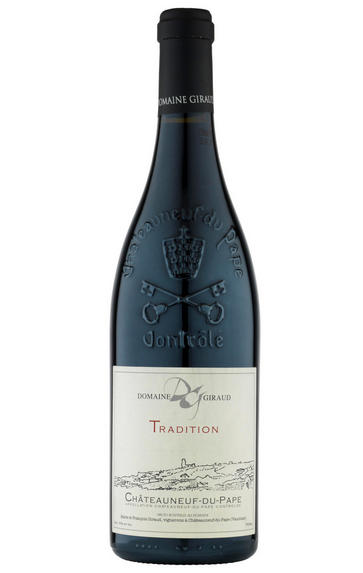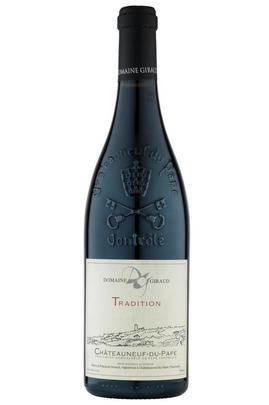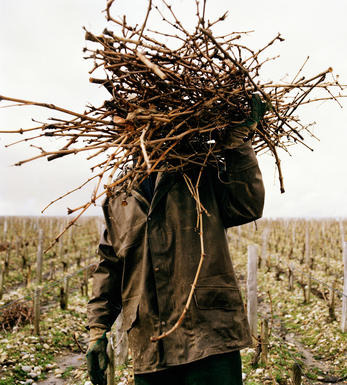
2011 Châteauneuf-du-Pape, Cuvée Tradition, Domaine Giraud, Rhône

Critics reviews
Jeb Dunnuck - 31/10/2013
This estate has acquitted itself impressively over the last 5-6 years. It first caught my attention with its brilliant 2007s, which were followed by strong efforts in 2009 and now their finest wines to date, the 2010s. Domaine Giraud is an old estate that has been reinvigorated by the enthusiasm of a younger generation, especially Marie Giraud. They own just over 40 acres in various Chateauneuf du Pape terroirs. The 2011 vintage was successful for Domaine Giraud, as evidenced by the following three wines. Without a doubt the 2010s are the greatest wines made to date by Francois and Marie Giraud.
Robert Parker, Wine Advocate #204, Dec 2012
About this WINE

Domaine Giraud
Domaine Giraud is new to our list this year. Having espied an impressive progression over the last three years, we feel that the 2009 has progressed even further. Marie Giraud is the talented winemaker and advice from the larger-than-life consultant Monsieur Philippe Cambie has brought the property to the boil. The biodynamic approach to viticulture was more than a match, it seems, for the intense heat of high summer, when moisture was at a premium.

Châteauneuf-du-Pape
The most celebrated village of the Southern Rhône, Châteauneuf-du-Pape is the birthplace of the now indispensable French Appellation d’Origine Contrôlée system – imperfect though it may be. Compared to the Northern Rhône, the vineyards here are relatively flat and often feature the iconic galet pebbles – the precise benefits of which are a source of much debate. Minimum alcohol levels required by the AOC are the highest in France, but at 12.5% it is well below the natural generosity of Grenache, which only achieves its full aromatic potential when it is fully ripe and laden with the resultant high sugars. Syrah and Mourvèdre contribute the other defining elements in the blend, adding pepper, savoury spice and structure to the decadent Grenache. There are a further 10 permitted red grape varieties which can be used to adjust the “seasoning”. Of the five white varieties permitted, it is Grenache Noir’s sibling – predictably perhaps – Grenache Blanc, which dominates, though Roussanne shows a great deal of promise when handled well, notably at Château de Beaucastel.

Southern Rhône Blend
The vast majority of wines from the Southern Rhône are blends. There are 5 main black varieties, although others are used and the most famous wine of the region, Châteauneuf du Pape, can be made from as many as 13 different varieties. Grenache is the most important grape in the southern Rhône - it contributes alcohol, warmth and gentle juicy fruit and is an ideal base wine in the blend. Plantings of Syrah in the southern Rhône have risen dramatically in the last decade and it is an increasingly important component in blends. It rarely attains the heights that it does in the North but adds colour, backbone, tannins and soft ripe fruit to the blend.
The much-maligned Carignan has been on the retreat recently but is still included in many blends - the best old vines can add colour, body and spicy fruits. Cinsault is also backtracking but, if yields are restricted, can produce moderately well-coloured wines adding pleasant-light fruit to red and rosé blends. Finally, Mourvèdre, a grape from Bandol on the Mediterranean coast, has recently become an increasingly significant component of Southern Rhône blends - it often struggles to ripen fully but can add acidity, ripe spicy berry fruits and hints of tobacco to blends.


Buying options
Add to wishlist
Description
A traditional blend for the traditional cuvée, or if you prefer a classic blend for the classic cuvée; the blend here is 60% Grenache, 35% Syrah and 5% Mourvèdre, with the ageing shared between tank and foudre. The relatively high percentage of Syrah adds focus and tone, with ripe black cherry and cassis evidenced alongside herbal descriptors picked from the kitchen garden.
Simon Field MW, BBR Buyer
Marie Giraud had deserved the recent flood of plaudits from the great and the good, including one rather influential commentator. With initial guidance from another larger than life character, oenologist Philippe Cambie, she has adopted a biodynamic approach across 18 hectares of vines, most of which are located to the east of the commune. In the early days I was anxious that extraction was concealing fruit quality; this is no longer the case.
wine at a glance
Delivery and quality guarantee